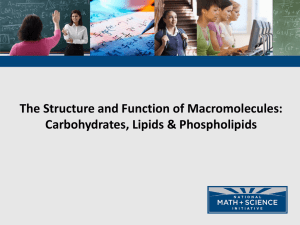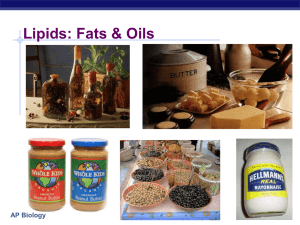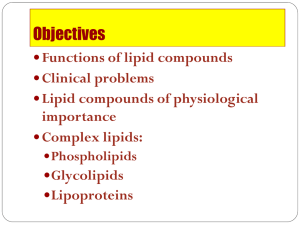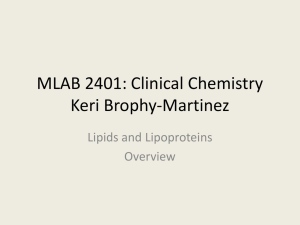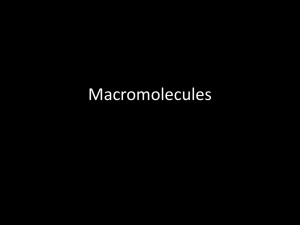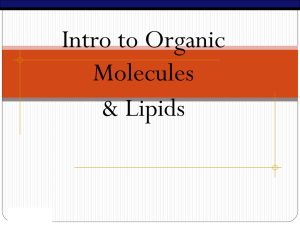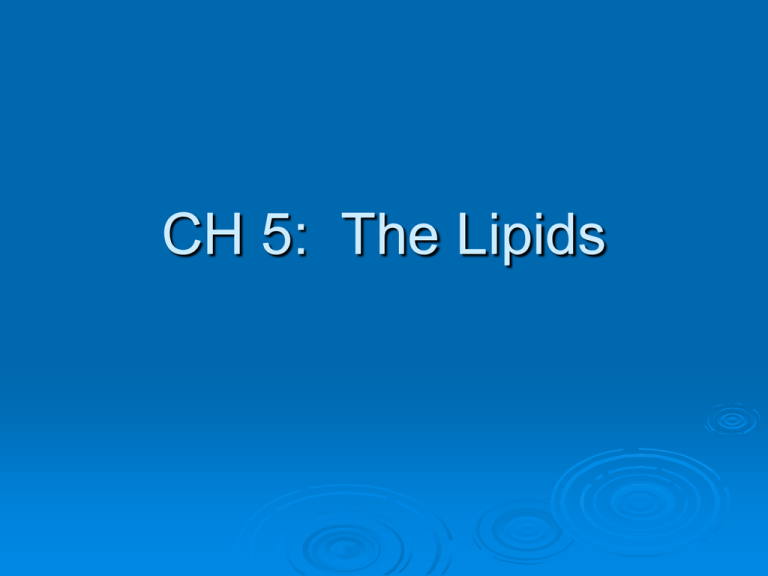
CH 5: The Lipids
Lipids include….
Fats
Butter, lard, margarine…
Oils
Plant oils - Corn oil, olive oil, peanut oil…
Cholesterol
Found in animal sources of fat
• Dairy, egg yolk, butter, fatty meats..
Recommended Lipid Intake
20-35
% daily kcal from fats (TG)
• Maximum 10% from saturated fats
• Some say maximum 10% from polyunsaturated
fats
• Minimum 20% calories from fats
• Limit intake of trans fats
Maximum
300 mg cholesterol per day
• No or lower cholesterol intake is fine/good
Introduction to Lipids
Lipids
– water insoluble component of
cells
Called hydrophobic
Made of the elements:
•
•
•
•
Carbon
Hydrogen
Oxygen
Phosphorus (in phospholipids only)
Introduction to Lipids
Classes of lipids:
Fatty acids (FA)
•
May be saturated or unsaturated
Triglycerides (TG) - the fats we eat
•
Phospholipids
•
9 kcal/gram
Also 9 kcal/gram
Sterols
•
Not caloric
Fatty Acids
Fatty
Acids - Long hydrocarbon chains
with an acid head (pg 168)
Carbon chains differ in:
• Length - most are 4-24 carbons long
• Number and type of double bonds
Fatty Acids
Saturated
Fatty Acids
All carbon to carbon single bonds
• Chain is saturated with hydrogens
Chain is relatively straight
Unsaturated
Fatty Acids
At least one C to C double bond present
• Called a “point of unsaturation”
Double bonds kink/bend the chain
Fatty Acids
Unsaturated Fatty Acids
Monousaturated
One C to C double bond
Polyunsaturated
FA (MUFA)
(PUFA)
More than one C to C double bond
Omega-3 and Omega-6 FA
An omega-3 fatty acid - double bond starting
on the 3rd carbon from the “methyl end”
(shown in green).
An omega-6 fatty - double bond starting on
the 6th carbon from the “methyl end”.
© 2008 Thmson - Wadsworth
Cis and Trans Fatty Acids
Hydrogenation Reaction
Hydrogenation
reaction adds hydrogens to
double bonds to convert them to single
bonds
TG may be partially or fully hydrogenated.
Hydrogenation
Partially
hydrogenated TG
Some of double bonds saturated (made single
bonds)
• As a result oils become ___________
The remaining double bonds are converted
from cis to trans form
• Cis form is the naturally occurring form
• Trans FA are associated with health risks
Hydrogenation
Fully
hydrogenated TG
All double bonds are saturated
• As a result oils become solids (stick margarine)
Converts an unsaturated oil to a saturated fat
• Fully hydrogenated fats have the same health
issues as natural sources of sat’d fats
Triglycerides
TG
– chemical nature
3 carbon backbone (called glycerol) with 3
fatty acids (FA) attached (page 171)
The chemical nature of the attached fatty
acids determines the physical properties of
the TG and its storage properties
TG
Back
to TG - Glycerol with 3 FA attached
Fatty Acid #1
Fatty Acid #2
Fatty Acid #3
FA attached may differ
Nature of FA impacts properties of the TG
Page 170
Triglyceride
Saturated TG
TG
with primarily saturated fatty acids
attached
Solids at room temperature (fats)
• Shorter the chain the softer the TG
Primarily from animal sources
More stable than TG w/ unsaturated FA
• Store better
Saturated FA are associated w/ health risks
Saturated TG Sources
Food
Sources Saturated Fats
Butter, cream, milk, cheese
Red meat
Coconut and palm oil – plant sources of
saturated fats
Chicken - mixture of sat’d and unsat’d fats
• Much of chicken fat is in the skin
Unsaturated TG
TG
with primarily unsaturated FA
Liquids at room temperature (oils)
Primarily from plant sources
Double bonds are reactive
• Therefore plant oils react with oxygen and go
rancid easily
Unsaturated TG Sources
Sources
of Unsaturated Fats
Monounsaturated
• Olive oil, canola oil, peanut oil
Polyunsaturated
• Corn oil, soybean oil, sunflower oil…..
Essential Fatty Acids
2
essential fatty acids
Omega-3 FA – linolenic acid
• May lower cholesterol and risk of heart disease,
hypertension, ?cancer, ?arthritis
• Good food sources: fish, soy, nuts, many oils
Omega-6 FA – linoleic acid
• Food sources are vegetable oils and poultry
© 2008 Thomson - Wadsworth
Phospholipids
Function:
structural component of all cell
membranes
Structure:
Glycerol backbone (3 carbon) with 2 fatty
acids attached and one phosphate group
Attached to phosphate group is some other
group
© 2008 Thomson - Wadsworth
Phospholipids
9
kcal/gram
Best known phospholipid is lecithin
Supplements are NOT needed
• Can cause GI distress, loss of appetite
Liver makes phospholipids for the body
Phospholipids
Food
sources:
Eggs (yolk only)
Liver
Soybean
Wheat germ
Peanuts
Sterols
Structure:
4 linked carbon rings with side
chains
Examples of sterols (we make in body)
Cholesterol
Vitamin D
Bile salts
Sex hormones
Digestion of Lipids
Digest
TG to:
Glycerol, fatty acids, and monoglycerides
Absorb:
Glycerol and short chain FA into capillaries
Longer chain FA and monoglycerides into
lacteals (complicated process)
Digestion of Lipids
Small
amount of chemical digestion occurs
in mouth and stomach
Infants have an enzyme that begins digestion
of TG found in milk – in mouth
Adults make a small amount of gastric lipase
• Begins digestion of TG in ______
Digestion of Lipids
Small
Intestine
Bile emulsifies fats (physical digestion)
Pancreatic and SI lipases remove FA from TG
and phospholipids
• Digestion produces:
• Fatty acids, glycerol, monoglycerides
• Sterols do not need digestion
Absorption
Glycerol
and short/medium chain FA
Absorbed into the capillaries
Go directly to the liver
Absorption
Long
chain FA and monoglycerides
Form micelles
Micelles are absorbed into SI cells
In SI cells TG are remade!
The newly made TG attach to protein carriers
to form chlyomicrons – page 157
Chylomicrons are absorbed into lacteals
© 2008 Thomson - Wadsworth
Transport
Chylomicrons
– lipoproteins
Travel through lymph and enter blood in chest
Travel through the heart and then body
• Enzymes break off fatty acids from TG and deliver
them to cells for energy or storage as TG
Chylomicron remnants are then delivered to
the liver
Transport
In the liver
Liver breaks down remaining TG and
remakes them!
• Liver also makes cholesterol and other TG
These TG and cholesterol are packaged with
proteins to make VLDL
• Very low density lipoproteins
Transport
VLDL
enters blood
VLDL delivers cholesterol and fatty acids
to needy cells
Density goes up as the fats leave the
transport protein
Transport
VLDL
becomes LDL as it loses FA
Low density lipoprotein
LDL is high in cholesterol
LDL circulates in blood delivering cholesterol
to cells
Transport
LDL
“Bad” cholesterol
Contributes to plaques when cholesterol “falls
off” the LDL and is deposited on artery walls
Plaques narrow arteries
• Raises blood pressure
• Increases risk of blood clots and heart attacks
Transport
HDL
High density lipoprotein
HDL transports cholesterol and other lipids
back to liver for disposal
• Can pick up cholesterol from plaques
• Good cholesterol
Cholesterol
Maximum
300 mg/day
Make all we need, so no intake is fine
Food
level of intake recommended
Sources – all animal (no plant sources)
Egg yolk
Dairy (unless fat removed as in skim milk)
Meat, poultry
Cholesterol
Blood
levels
Goal: total cholesterol < 200 mg/dL (know this one)
Other recommendations (do not need to know)
• LDL < 100 mg/dL
• HDL > 60 mg/dL
• LDL:HDL ratio to be less than 5 for men and less
than 4.5 for women
• Triglycerides < 150 mg/dL
Lowering Cholesterol Levels
Reduce intake of:
1.
•
•
•
•
Saturated fats
Trans fatty acids
Cholesterol
Sugars (if sugar sensitive)
Increase intake of:
2.
•
•
soluble fibers (oats and legumes)
fish
Lowering Cholesterol Levels
3.
4.
5.
Moderate alcohol intake
Exercise – aerobic may be best
Lose weight
FYI - Estrogen lowers cholesterol levels
Therefore, cholesterol levels often go up in
postmenopausal women.
Weight Loss and Cholesterol
Year
2003
2004
Weight
235 pounds
195 pounds
Total
cholesterol
HDL
302
157
68
53
LDL
193
88
Triglycerides
206
97
Genetics Matter
Male with a healthy weight and active lifestyle, but
family history of heart disease
Total
chol.
HDL
Initial After Dietary
values Changes
242
214
After
Meds.
151
40
36
36
LDL
157
132
74
TG
223
230
203
Functions of Fats in the Body
Source of energy
Thermal insulation
Protect and supports organs
1.
2.
3.
•
Fats hold some organs in place
Use to make all cells
Use to make important substances
4.
5.
•
E.g. sex hormones, bile……
Review Fat Sources
Saturated
Fats
Monounsaturated Fats
olive, canola and peanut oil and avocados.
Polyunsaturated
Fats
vegetable oils (safflower, sesame, soy, corn and
sunflower), nuts and seeds.
Trans Fatty Acids
Cholesterol
Review Health Aspects Fats
Saturated
Fats
Trans Fatty Acids
Cholesterol
Monounsaturated
Fats
Polyunsaturated Fats
Health Effects and Recommended
Intakes of Lipids
Health
Effects of Lipids
Benefits from Omega-3 Fats
• Beneficial effects in reducing risk of heart disease
and stroke
• Food sources include vegetable oils (canola,
soybean and flaxseed), walnuts and flaxseeds,
and fatty fish (mackerel, salmon, and sardines).
Need to avoid fish with high levels of mercury
© 2008 Thomson - Wadsworth
Health Effects and Recommended
Intakes of Lipids
Health
Effects of Lipids
Balance Omega-6 and Omega-3 Intakes
• Eat more fish (2 3-oz. portions per week) and less
meat.
• Bake, broil or grill the fish.
• Select healthy oils – in moderation
• Supplements are not the answer.
© 2008 Thomson - Wadsworth
© 2008 Thomson - Wadsworth



